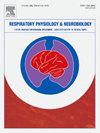Two-day cardiopulmonary exercise testing in long COVID post-exertional malaise diagnosis
IF 1.6
4区 医学
Q3 PHYSIOLOGY
引用次数: 0
Abstract
Background
Long COVID patients present with a myriad of symptoms that can include fatigue, exercise intolerance and post exertional malaise (PEM). Long COVID has been compared to other post viral syndromes, including myalgic encephalomyelitis/chronic fatigue syndrome (ME/CFS), where a reduction in day 2 cardiopulmonary exercise test (CPET) performance of a two-day CPET protocol is suggested to be a result of PEM. We investigated cardiopulmonary and perceptual responses to a two-day CPET protocol in Long COVID patients.
Methods
15 Long COVID patients [n=7 females; mean (SD) age: 53(11) yr; BMI = 32.2(8.5) kg/m2] performed a pulmonary function test and two ramp-incremental CPETs separated by 24 hr. CPET variables included gas exchange threshold (GET), peak oxygen uptake (O2peak) and peak work rate (WRpeak). Ratings of perceived dyspnoea and leg effort were recorded at peak exercise using the modified 0–10 Borg Scale. PEM (past six months) was assessed using the modified DePaul Symptom Questionnaire (mDSQ). One-sample t-tests were used to test significance of mean difference between days (p<0.05).
Results.
mDSQ revealed PEM in 80 % of patients. Lung function was normal. Responses to day 1 CPET were consistent with the presence of aerobic deconditioning in 40 % of patients (O2peak <80 % predicted, in the absence of evidence of cardiovascular and pulmonary limitations). There were no differences between day-1 and day-2 CPET responses (all p>0.05).
Conclusion
PEM symptoms in Long COVID patients, in the absence of differences in two-day CPET responses separated by 24 hours, suggests that PEM is not due to impaired recovery of exercise capacity between days.
长 COVID 运动后瘫痪诊断中的两天心肺运动测试
背景:长期慢性阻塞性肺病(COVID)患者会出现各种症状,包括疲劳、运动不耐受和劳累后乏力(PEM)。长 COVID 与其他病毒后综合征(包括肌痛性脑脊髓炎/慢性疲劳综合征(ME/CFS))进行了比较,后者在为期两天的 CPET 方案中,第 2 天的心肺运动测试(CPET)成绩下降被认为是 PEM 的结果。我们研究了 Long COVID 患者对两天 CPET 方案的心肺和知觉反应。方法:15 名 Long COVID 患者[n=7 名女性;平均(标清)年龄:53(11)岁;体重指数 = 32.2(8.5)千克/平方米]进行了肺功能测试和两次斜坡递增 CPET,每次间隔 24 小时。CPET 变量包括气体交换阈值 (GET)、VO2 峰值和 WR 峰值。在峰值运动时,使用改良的 0-10 Borg 量表记录感觉到的呼吸困难和腿部用力情况。使用改良的德保罗症状问卷(mDSQ)对过去 6 个月的 PEM 进行评估。采用单样本 t 检验来检验不同天数之间平均差异的显著性(p 结果:mDSQ 显示 80% 的患者患有 PEM。肺功能正常。第 1 天 CPET 的反应与 40% 的患者存在有氧机能减退一致(V̇O2peak 0.05):结论:长COVID患者出现劳累后乏力症状,而相隔24小时的两天CPET反应却没有差异,这表明劳累后乏力并不是由于几天之间运动能力恢复受损所致。
本文章由计算机程序翻译,如有差异,请以英文原文为准。
求助全文
约1分钟内获得全文
求助全文
来源期刊
CiteScore
4.80
自引率
8.70%
发文量
104
审稿时长
54 days
期刊介绍:
Respiratory Physiology & Neurobiology (RESPNB) publishes original articles and invited reviews concerning physiology and pathophysiology of respiration in its broadest sense.
Although a special focus is on topics in neurobiology, high quality papers in respiratory molecular and cellular biology are also welcome, as are high-quality papers in traditional areas, such as:
-Mechanics of breathing-
Gas exchange and acid-base balance-
Respiration at rest and exercise-
Respiration in unusual conditions, like high or low pressure or changes of temperature, low ambient oxygen-
Embryonic and adult respiration-
Comparative respiratory physiology.
Papers on clinical aspects, original methods, as well as theoretical papers are also considered as long as they foster the understanding of respiratory physiology and pathophysiology.

 求助内容:
求助内容: 应助结果提醒方式:
应助结果提醒方式:


